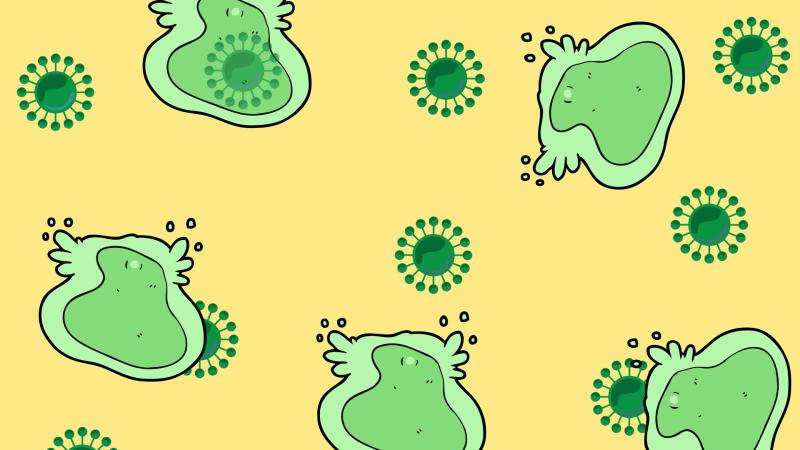
Being big, like an elephant or a rhinoceros, has a significant advantage—no predator would dare tackle such a large animal! However, some viruses, like the one that infects the single-celled amoeba, are big for a different reason—to sneak into its host, the amoeba. In a new study, researchers from the Indian Institute of Technology Bombay (IIT Bombay), have found a relationship between the number of copies of a particular set of genes and the size of the amoeba viruses that help these viruses to gain easy entry into their host.
Viruses are organisms containing an outer protein coat called the capsid and genetic material, either DNA or RNA. Unlike a bacteria, viruses cannot replicate themselves as they do not contain all the genes required for replication. Hence, they infect a suitable host cell and subvert its normal processes to prepare a few proteins and enzymes needed for their replication. Different viruses use different strategies to gain entry inside the host cell. The amoeba virus uses its size to con its host through the very process used by an amoeba to eat.
In this study, published in the journal Virus Evolution, the researchers elucidate how the amoeba virus increases its size by using a set of essential genes called RDCPs (Repeat Domain Containing Proteins) to expand its genome length and to infect the host once inside the amoeba cell. The research was supported by the Department of Science and Technology and the Department of Biotechnology.
“It has been observed that in amoebal viruses, the number of RDCPs increases with increase in the genome size, and most of these proteins are located at the end of the genome. The multiple copies of RDCPs could be the result of their lineage-specific expansion in giant viruses. Their sheer number adds up and increases the genome size”, says Prof. Kiran Kondabagil from IIT Bombay, in an interview with Research Matters. This finding is an exception to the earlier belief that viruses, thriving inside other cells as intracellular parasites, have small genomes.
So, how does being big help the virus? Amoeba eats through a process called phagocytosis, where it engulfs its food, usually bacteria, and absorbs it into its cell. Hence, the amoeba virus tries to look like a bacteria by growing big, to draw the amoeba's attention and sneak into its cell when the hapless amoeba engulfs it mistaking it for bacteria. “The threshold particle size for successful phagocytosis in amoeba is thought to be 0.5 µm. As it predates on many microorganisms, we think that the amoebal viruses need to be of a similar size range”, says Prof. Kondabagil.
Once the virus enters the amoebal cell, it unleashes a set of processes that allow it to hijack the cellular machinery to help its replication. The host's defence mechanism is the last hurdle in doing so. Inside the amoebal cells are bags of acerbic enzymes called lysosomes, which, digest the engulfed bacterium in the phagosome (a sac-like structure) to derive nourishment in the normal process of phagocytosis.
When the amoebal virus enters the host cell, it needs to avoid contact with lysosomes at any cost! The researchers found that the amoebal virus escapes being digested in the host cell by using the RDCP genes, whose products mark the phagosomes differently so that lysosomes fail to recognise them as fit for digestion. These genes also subvert the defence proteins of the host to avoid premature destruction. Once a virus has infected an amoeba, it is not advantageous for the virus inside to have another virus infecting the same cell. Therefore, through the RDCP proteins, the virus modifies the shape and structure of the infected cell in a way that no new virus can infect it.
The acquisition of more copies of these genes themselves, in the genome of the virus, is also exciting! “The virus may acquire the RDCP genes from different genetic elements that move around, through a process called horizontal gene transfer", says Prof. Kondabagil. Horizontal gene transfer is a process where genes from any organism, irrespective of the species they belong to, are acquired by an organism. The virus also could then increase the number of RDCP genes through duplication.
The study convincingly explains the role of RDCP genes that help the amoebal virus gain entry into the host and lets it survive despite the host's defence mechanisms. These genes, present in multiple copies at the terminal ends of the viral genome, also protects the central core of the genome. “The numeric correlation of RDCPs with genome size might have an evolutionary significance. Their arrangement may be crucial for these viruses to adapt to a wide variety of hosts and out-compete prokaryotes and other viruses", says Prof. Kondabagil, talking about the importance of the findings, which could also help us understand the evolution of viruses.






